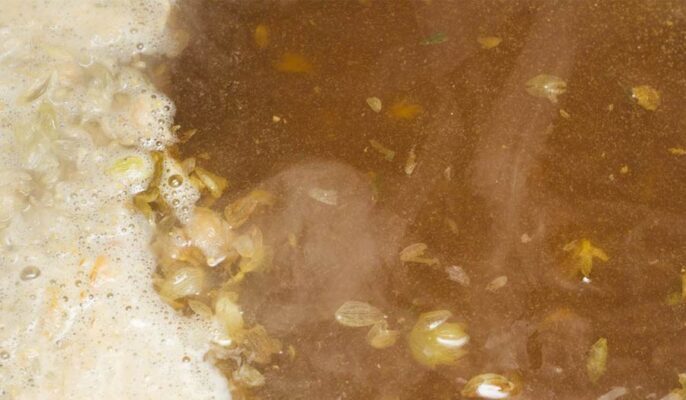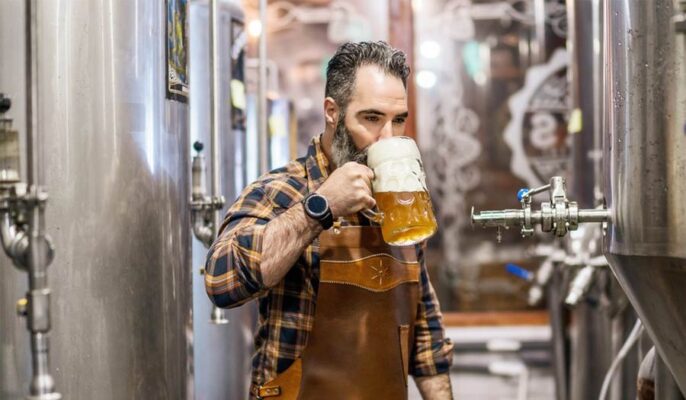Kvašení je proces, při kterém kvasinky přeměňují glukózu v mladině na etanol a oxid uhličitý. Pro zahájení procesu kvašení se vychlazená mladina přelije do nádoby s kvasnicemi. fermentační nádrž do kterého byly přidány kvasnice. Bez kvašení nevzniká alkohol, nedochází k degradaci cukru ani ke správnému rozvoji chuti.
Kvašení piva vyžaduje kvasinky
Ke kvašení piva jsou zapotřebí kvasinky. Kvasinky během kvašení přeměňují glukózu na oxid uhličitý a etanol. Toto kvašení nepotřebuje žádný kyslík. Kvasinky jsou živé mikroorganismy, které musí být správně kultivovány, aby se jim dařilo. Musí být správná teplota a dostatek potravy (glukózy), aby kvasinky mohly vykonávat svou práci. Prvních několik kroků vaření piva tedy spočívá ve vytvoření správného prostředí pro kvasinky, aby se jim dařilo.

Jak dlouho trvá kvašení piva?
Mnoho pivovarníků si klade otázku, jaká je optimální doba kvašení piva. Dobu kvašení nemůžeme ovlivnit. Po vhození do kvasnic odvedou veškerou práci kvasnice.
Kontrola doby fermentace
Regulace teploty je velmi důležitou součástí procesu kvašení a lze ji měnit i v průběhu kvašení. Každý kmen kvasinek má svůj teplotní rozsah, ve kterém nejlépe pracuje. Různé teploty v tomto rozmezí ovlivňují fermentovatelnost různých kvasinek. Obecně platí, že čím nižší teplota, tím pomaleji kvasinky působí, a čím vyšší teplota, tím rychleji.
Čím vyšší je teplota kvašení mimo teplotní rozsah určený kvasinkami, tím větší je pravděpodobnost, že se v pivu objeví vedlejší chutě a nežádoucí vlastnosti. Při použití nižších teplot může někdy dojít ke stagnaci, prodloužení doby kvašení nebo potížím s dosažením normální úrovně kvašení. Samozřejmě s výjimkou některých specifických stylů.
Základní zkušenosti s fermentací
Při kvašení kvasinek se zaměřte na nízké až střední teploty. Například pokud je rozsah 18-22 °C, je nejlepší se zaměřit na 19-20 °C.
Proces kvašení piva
Once there is enough “food” in the wort and the first flavor development (by adding hops) is complete, the fermentation process can begin. Yeast are added to the liquid and they can start consuming glucose.
Fermentation doesn’t always start right away. Oxygen is still present at the start, allowing the yeast to breathe instead of ferment. When breathing yeast uses oxygen to break down glucose. Here no ethanol is formed, but the glucose is completely broken down into water and carbon dioxide, obtaining all possible energy from the glucose molecules.
Základní proces kvašení piva je stejný jako u běžného kvasnicového kvašení. Glukóza se mění na etanol (alkohol) a oxid uhličitý. Během kvašení však dochází k více než jen ke vzniku těchto dvou molekul!
Jak poznáte, že pivo dokvasilo?
Častou chybou začínajících vinařů je, že k měření průběhu kvašení používají vzdušný uzávěr na kvasné nádobě. Zařízení, které zajišťuje, že se do kvasícího piva nic nedostane, a umožňuje únik nahromaděného CO2. Pokud není fermentor uzavřen , může CO2 unikat a vzduchový zámek přestane bublat!
There is only one way to know if a beer has finished fermenting – with a hydrometer or a refractometer. These devices allow you to check the sugar content in your wort/beer.
Obecným doporučením, jak poznat, kdy je pivo hotové a připravené k balení, je získat stabilní hodnotu specifické hmotnosti (SG) během 2-3 dnů. Tím se zajistí, že kvašení bylo skutečně dokončeno.

Co dělat po dokončení kvašení piva?
Po vykvašení nechte pivo několik dní odstát. Pivo se tak usadí a vyčistí a kvasinky se na dně kvasné nádoby vyflokují. Pokud můžete trochu snížit teplotu, doporučujeme tuto metodu, protože pomáhá vyčistit pivo.
Po ukončení fermentace je možné okamžité balení. Chtělo by to zrát déle nebo přidat další věci, jako je ovoce, dub, nebo samostatně v některých ležácích. Vše záleží na vařeném pivu.
Jak vypadá kvašené pivo
Doba zpoždění
V této fázi se kvasinkové buňky probudí. Začnou hledat potravu jako člověk, například kyslík, minerály a aminokyseliny. V této fázi nedochází kvůli případnému zbývajícímu teplotnímu rozvrstvení k žádné aktivitě vzdušného zámku a ve fermentoru konvexně proudí jen malé množství mladiny.
Pevné období
All the sugar has been eaten and it starts to turn from milky white to yellow and brown. Yeast begins to take up many of the compounds of as off-flavors, such as higher alcohols, diacetyls, sulfur compounds, and esters, and converts them into more alcohol and other “better” esters.
At this point, the fermented wort, known as a “green” beer, has not yet achieved the proper balance of flavors. The airlock and convection start to slow down as the yeast settles and goes to sleep after the long run, exiting the solution as the little food left over disappears.
Fáze dokončení prací
Může dojít k zastavení činnosti vzduchové komory (nebo bublinek) a k zastavení konvekce. Kvasinky v tomto okamžiku většinu času spí a visí na dně fermentoru. Pivo se začíná projasňovat a chutě v něm dozrávají.




